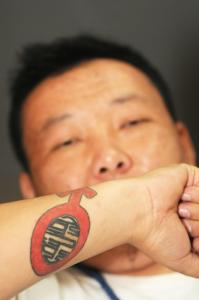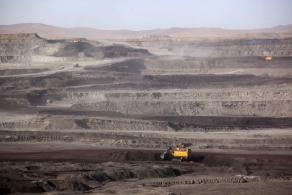| Agence France-Presse |
| September 21, 2012 |
| Hohhot, China |
 |
|
|
Rappers
(L-R)
Beggar,
Sodmuren
and Mars
(L-R)
from
hip-hop
band "Poorman"
recording
their
music in
Hohhot,
north
China's
Inner
Mongolia
region.
Photo
courtesy:
AFP
|
|
 |
|
|
Rapper
Sodmuren
of
hip-hop
band "Poorman",
in
Hohhot,
north
China's
Inner
Mongolia
region.
Photo
courtesy:
AFP
|
|
 |
|
|
Rapper Bondoo of hip-hop band "Poorman", displaying his tattoo on his wrist during an interview in Hohhot, north China's Inner Mongolia region. Photo courtesy: AFP
|
|
 |
|
|
Workers
driving
trucks
at a
coal
mine in
Huo Lin
Guo Le,
China's
north
Inner
Mongolia
region.
Photo
courtesy:
AFP
|
|
 |
|
|
People
working
at a
coal
mine in
Huo Lin
Guo Le,
China's
north
Inner
Mongolia
region.
Photo
courtesy:
AFP
|
|
 |
|
| Trucks being driven at a coal mine in Huo Lin Guo Le, China's north Inner Mongolia region. Photo courtesy: AFP | |
The sparsely populated region in northeastern China counts mining and milk among its main industries, and locals are more familiar with throat-singing than rapping.
But members of China's Mongolian ethnic minority, whose ancestors were first united by Genghis Khan, are turning to hip hop to condemn the resources boom they say is wreaking havoc on their traditions and lands -- while avoiding the authorities' attention.
"Herders are bribed with cash, and our land is torn up by machines," the trio, who go by the English name Poorman, rap in their track "Tears". "Brothers and sisters, we need to wake up!"
Once an economic backwater, the development of thousands of coal mines to tap Inner Mongolia's vast mineral reserves has made the region one of China's fastest-growing.
But while some have prospered from the mining boom, other Mongolians resent being displaced from their land to make room for the mines, which they say scar the steppe and discriminate against them in recruiting.
"There are all these songs about the beauty of Inner Mongolia's grasslands, but when people come to visit they realise it's being turned into desert," said band member Sodmuren, 25, who like many Mongolians uses a single name.
The region's rappers adopted the genre a decade ago from their ethnic fellows in neighbouring Mongolia, an independent country which has had a thriving hip hop scene for more 20 years.
"Hip hop is the most honest kind of music there is," Sodmuren told AFP in a recording studio in Inner Mongolia's capital, Hohhot, where swathes of newly built concrete apartment blocks stretch into the grassy countryside.
China's Mongolians have seen their traditional way of life transformed by government policies encouraging nomadic herders to abandon their grazing lands for flats in the cities.
As a result, most of the region's rappers grew up in an urban environment. But Sodmuren and his bandmates retain a fascination with nomadic culture, incorporating pastoral imagery into their music.
"We grew up in yurts"
One of Poorman's videos shows the band sitting outside traditional tents, known as yurts, with one member wearing the deel, a Mongolian gown.
"Although we grew up in yurts, after years in the city we're forgetting our culture," they sing.
A few minutes' drive away from their studio, a sprawling Gucci store is testament to the new class of millionaires created by the mining boom, and their splurging on luxury cars and clothing.
But Eregjin, a baseball-capped 27-year-old solo rapper who has been singing under the name MC Bondoo since he was a teenager, said: "We don't admire luxury culture. We hate materialism, and the worship of expensive things."
He has the national symbol of independent Mongolia tattooed on his right arm.
Mongolians are one of dozens of minority groups who live along China's borders and speak Mandarin as a second language, seeing themselves as culturally different from the majority Han Chinese -- now 79 percent of Inner Mongolia's population.
Mandarin is increasingly popular for economic reasons even among Mongolians, and the rappers see their songs as a way to keep their own tongue alive.
"We're worried about the future of the Mongolian language, because there are fewer and fewer children attending bilingual schools," Sodmuren said. "The danger is that we'll lose our Mongolian identity."
Ethnic identification can be a sensitive topic in China, where the government is anxious to avoid social unrest.
When a Han Chinese coal truck driver ran over a Mongolian herdsman in 2011 it triggered more than a week of protests by hundreds of people in cities and towns across the region.
A rapper known as Syrlig was detained by authorities in 2011 after writing a song called "Stand up, Inner Mongolians!" several singers told AFP. He has since moved to Mongolia, the rappers said.
"There are some lyrics we'd sing in shows, but if we published them we'd be arrested," MC Bater, a member of one of Inner Mongolia's most successful hip hop groups, PTS, told AFP.
But the scene's low profile, combined with a degree of self-censorship -- declining to target individuals or the ruling Communist Party by name -- allows Mongolian rappers to escape censure from the authorities.
"I complain about government officials in my songs, but I don't name anyone directly," Sodmuren said. "I have to be smart."







